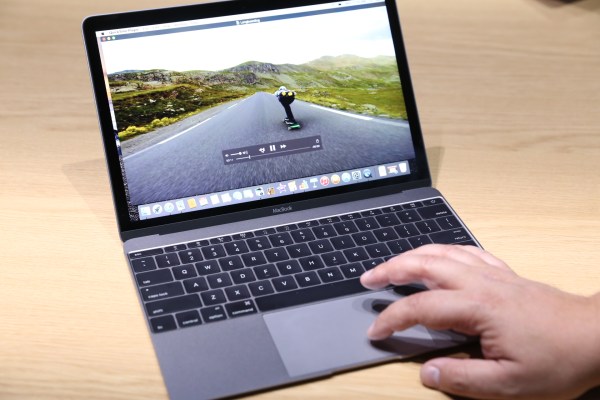Apple’s newest MacBook is clearly designed to set the stage for all Apple notebooks to come – it has a dramatically thin body, which measures only 13.1 mm deep at its thickest point, and a 12-inch display with a very small surrounding bezel. The screen has Retina resolution of 2304×1440, with a 16:10 aspect ratio, and the computer has just one port for power and data input/output (plus a 3.5mm stereo jack for headsets). It really is, top to bottom, a computer that pushes the edge of technical advancement forward, and Apple’s decision to call it simply the “MacBook” signals that this is the way of the future.
In person, the computer’s technical achievements are even more stunning than they were on stage. The notebook weighs only around 2 lbs, which is amazingly only about half a pound heavier than the original iPad. Holding it in the hand tricks your mind into thinking it’s even lighter, though, thanks to that larger display and the fact that you remember it’s actually a notebook.
The screen also looks unbelievable given what you might expect were the technical limitations that come along with making something so thin. The display looks printed on, with a resolution that renders text really well and looks a lot brighter, bolder, and more color-accurate than the original Retina MBP by quite a bit. Again, this is a screen built into something that is essentially not much thicker than a file folder.
[gallery ids="1129651,1129652,1129653,1129654,1129655,1129656,1129657,1129658,1129659,1129660,1129662,1129664,1129665,1129668,1129669,1129670,1129673,1129674,1129675,1129676,1129677,1129678"]
Apple has still included a full-size keyboard in this device, but it has used a new key process to create a keyboard with less travel, wider keys and less space between keys. Typing on the new MacBook feels good, though, with a satisfying click still present despite the shorter travel distance. Apple says this is because the keys click downward evenly across the key with the new mechanism, and limited hands-on testing seems to back that up.
The touch pad may be one of the more amazing feats in this machine, however, because despite only ever moving a total of 7 nanometers, it feels like it’s a clicky, button-like trackpad with real travel. That’s because it has customizable force feedback, which lets users say just how much the taptic engine beneath will respond to clicks. This proves amazing when you’re doing something like force pressing (applying more pressure) to quickly skim through video – you can actually feel the keypad providing you with subtle but distinct cues that it’s working.
Further testing will answer the question of whether Apple’s right that you don’t need additional ports to get your work and personal computing tasks done anymore, but I can say that the MacBook definitely lives up to its initial promise of being an amazingly thin and light device with very cool features that reimagine basics like keyboard illumination and trackpad input.

